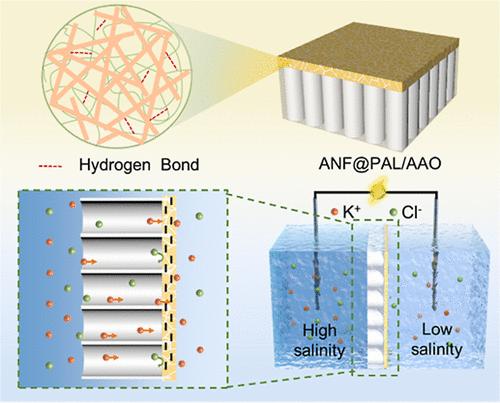增强空间电荷的粘土基纳米流控膜用于强渗透能量收集
IF 8.2
2区 材料科学
Q1 MATERIALS SCIENCE, MULTIDISCIPLINARY
引用次数: 0
摘要
通过过选择膜将盐梯度能转化为电能,对缓解能源危机具有很大的潜力。然而,选择性和渗透性之间的竞争,以及传统的透选择膜的不稳定性,限制了它们的实际应用。本文制备了一种坚固的粘土基芳纶nanofiber@palygorskite/阳极氧化铝(ANF@PAL/AAO)纳米流控膜,该膜具有三维互连网络,可用于高效的渗透能量收集。由针状聚乳酸堆叠而成的三维互联纳米通道为离子传递提供了更多更短的路径,从而提高了渗透率。此外,PAL的表面电荷与ANFs带来的空间电荷之间的协同作用提高了离子选择性,进一步提高了能量转换性能。结果表明,制备的ANF@PAL/AAO膜在500倍NaCl梯度下的输出功率为45 W m-2,能够承受酸碱度和高盐度环境。本工作为粘土基纳米流体器件在实际能量转换中的应用铺平了道路。本文章由计算机程序翻译,如有差异,请以英文原文为准。

Clay-Based Nanofluidic Membrane with Enhanced Space Charge for Robust Osmotic Energy Harvesting
Converting the salinity gradient energy into electric energy through permselective membranes has great potential to alleviate the energy crisis. However, the competition between selectivity and permeability, along with the instability of traditional permselective membranes, limits their realistic applications. Herein, a robust clay-based nanofluidic membrane of aramid nanofiber@palygorskite/anodic alumina oxide (ANF@PAL/AAO) with a 3D interworking network has been fabricated for efficient osmotic energy harvesting. The 3D interconnected nanochannels stacked by needle-like PAL provide more and shorter paths for ion transport, thereby increasing the permeability. Moreover, the collaboration between the surface charge of PAL and the space charge brought by ANFs improves ion selectivity, further enhancing the energy conversion performance. Results show that the as-prepared ANF@PAL/AAO membrane displays a power output of 45 W m–2 at 500-fold NaCl gradient and can withstand acidity/alkalinity and high salinity environments. The present work paves a facile way for the application of clay-based nanofluidic devices in practical energy conversion.
求助全文
通过发布文献求助,成功后即可免费获取论文全文。
去求助
来源期刊

ACS Applied Materials & Interfaces
工程技术-材料科学:综合
CiteScore
16.00
自引率
6.30%
发文量
4978
审稿时长
1.8 months
期刊介绍:
ACS Applied Materials & Interfaces is a leading interdisciplinary journal that brings together chemists, engineers, physicists, and biologists to explore the development and utilization of newly-discovered materials and interfacial processes for specific applications. Our journal has experienced remarkable growth since its establishment in 2009, both in terms of the number of articles published and the impact of the research showcased. We are proud to foster a truly global community, with the majority of published articles originating from outside the United States, reflecting the rapid growth of applied research worldwide.
 求助内容:
求助内容: 应助结果提醒方式:
应助结果提醒方式:


